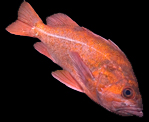
Blue rockfish, Sebastes mystinus
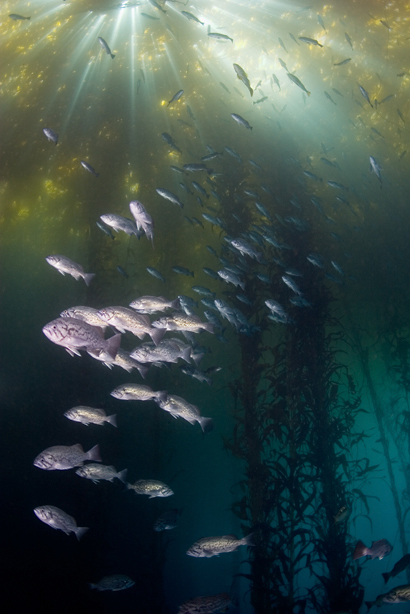
At depth, stands of giant kelp (Macrocystis sp.) are sparse. On the
water's surface, however, their lush canopy may permit only a few beams of
sunlight to pass. The surreal sensation of swimming just beneath the canopy as
these always dancing and occasionally blinding rays contrast with the shadows of
lurking blue rockfish (Sebastes mystinus) enchants almost all who
experience it. Environmental activist and long time dive boat captain Ed Cooper
was so taken with these lights that he named them "God beams". It's a fitting
appellation for one of many dive experiences that photograph poorly. This is
easily the closest I've come to capturing the feeling, but it lacks the sense of
immersion that comes with the real thing.
"Butterfly House", Carmel Bay, California
July 23, 2005
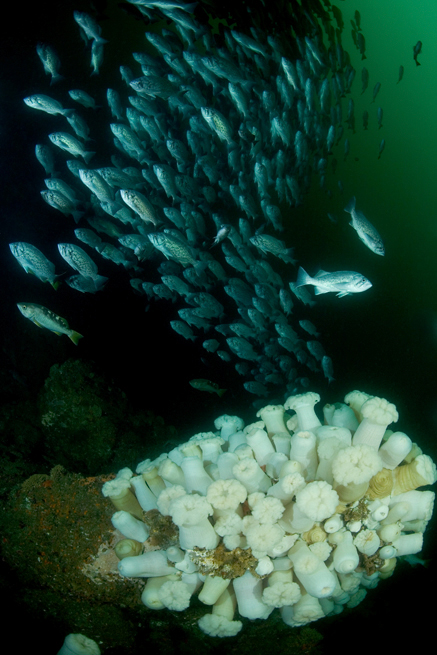
Blue rockfish (Sebastes mystinus) are Monterey's most interesting
schooling fish, particularly when they pack into large, dense aggregations like
this. The corner to corner angle of view in this shot is a full 180 degrees, but
even so, it seems a little too narrow. Super wide angle lenses are, of course,
great for the underwater photographer since they allow pictures of large reef
scenes unobscured by particulate matter in the water. At some point, however,
things start getting difficult. With my current lens, I have to be careful to
keep hands and elbows out of the shot. With a lens that was wider still, I
suspect I might have to -- as a friend of mine has suggested -- tape back my
ears or something. While big schools like this can still be found in more remote
places, it's quite unusual to see something like this in areas that are under
heavy fishing pressure. Actually, in many hundreds of dives in Monterey bay,
this is the only such school I've seen. That this school was considerate enough
to swim next to a big bunch of Metrdidium farcimen was an added bonus.
I'm a extra fond of this picture because it's the only reasonably good shot I've
taken while swimming backwards. "Backwards?" you say. Yes, as it turns out, one
of the charms of the 60's era Scubapro fins I use is that they are particularly
well-suited to swimming backwards. It's something that takes a bit of practice,
but is not so unreasonable as it sounds. And, no, there are no hands involved in
this backward swimming. All this being said, it's most often used to get oneself
out of a tight spot when current or surge is about to smash one into the end of
a narrow hole or crack in the reef. In such situations I'm usually more worried
about scratching my camera port than I am about getting a shot. In this case
however, I was able to correct for an initial overshoot in approaching the
subject. Hopefully this means I've managed to add one more item to my bag of
photographic tricks.
"Ballbuster", Monterey Bay, California
October 15, 2006
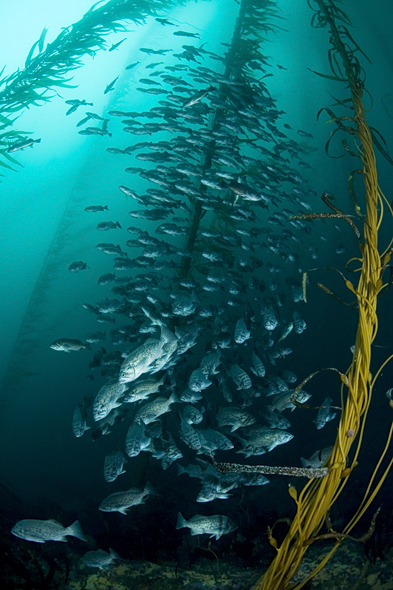
Blue rockfish (Sebastes mystinus) pack into tight schools when currents
are running. Although difficult to photograph, this is most certainly one of my
favorite scenes. The local sea lions seem to like these dense aggregations as
well. Watch such a school for a few minutes and you'll likely see the entire
mass dart toward the reef in fright as one or more of our furry friends
approach. Interestingly enough, the sea lions appear to do this as much for
their own amusement as for any other reason
"Outer Pinnacles", Carmel Bay, California
August 13, 2006
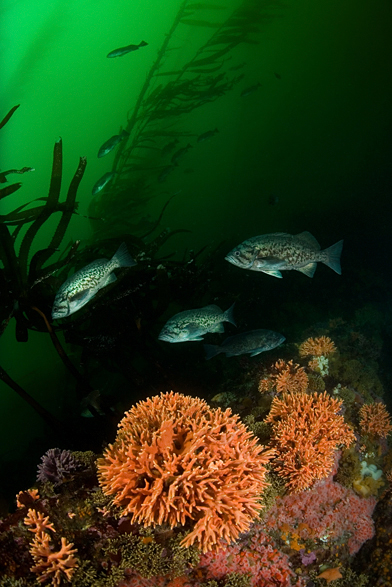
California hydrocoral (Stylaster californicus) and blue rockfish
(Sebastes mystinus). Like many of us, blue rockfish are fairly averse to
doing more work than they need to do. The fish in the background of this shot
are hiding in the lee of a stalk of kelp so that they don't have to swim against
the current. It might seem surprising that a fish would need to do this.
However, your average reef fish isn't really built for long extended swims. And,
of course, rockfish seem to spend a great deal of their lives running away from
the local pinnipeds. I imagine they appreciate the odd opportunity to take it
easy for a bit.
"Outer Pinnacles", Carmel Bay, California
August 20, 2006
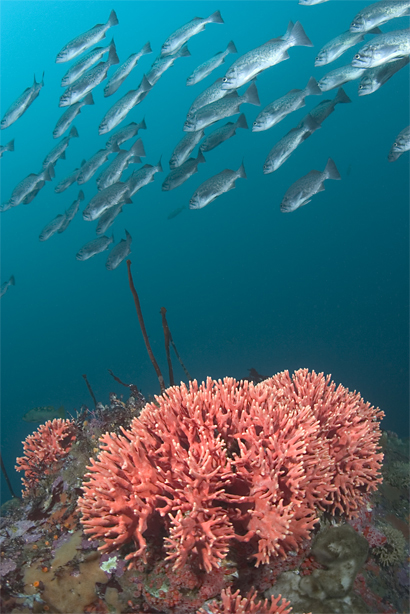
California hydrocoral (Stylaster californicus) and blue rockfish
(Sebastes mystinus).
"East Pinnacles", Carmel Bay, California
January 22, 2006
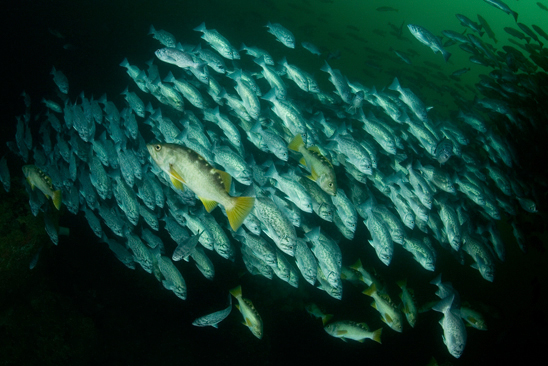
This olive rockfish (Sebastes serranoides) is bucking the trend set by
his blue rockfish (Sebastes mystinus) peers. Likely the camera got a
little too close for comfort.
"Ballbuster", Monterey Bay, California
October 15, 2006
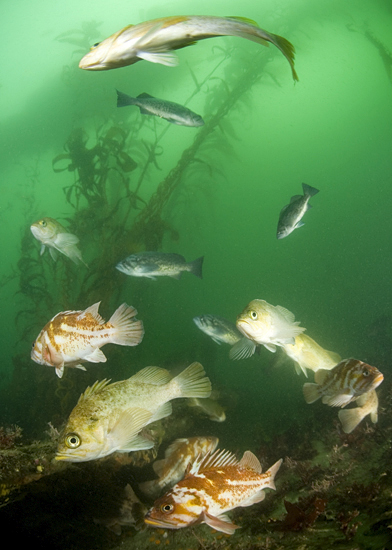
This is my entrant in the "How many different species of rockfish can you fit in
a single photograph?" competition. I think there are five different members of
the genus Sebastes here. That is, blue (S. mystinus), kelp (S.
atrovirens), copper (S. caurinus), black and yellow (S.
chrysomelas) and the fairly uncommon, at least for the Monterey area, brown
(S. auriculatus). There are actually two specimens each of the last two
species, but all four fish are fairly well hidden.
"Tanker Reef", Monterey Bay, California
July 23, 2006
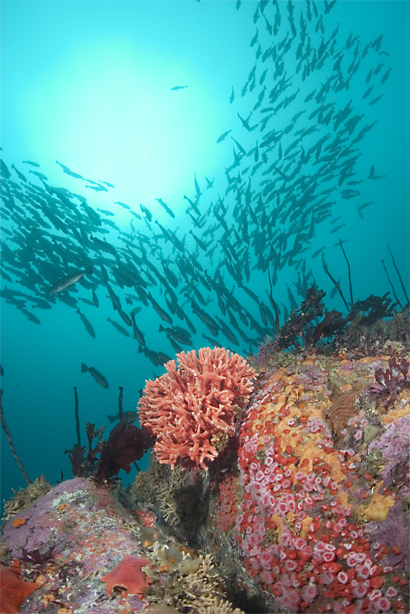
California hydrocoral (Stylaster californicus) and blue rockfish
(Sebastes mystinus) cradle a sunburst. When shooting wide angle, cold
water photographers often prefer to look directly at the sun like this. While
the photographer may get a little bleary-eyed watching a backlit scene, the
camera's autofocus appears unaffected. The increased background light makes it
easier to achieve a picture with balanced lighting.
"East Pinnacles", Carmel Bay, California
January 22, 2006
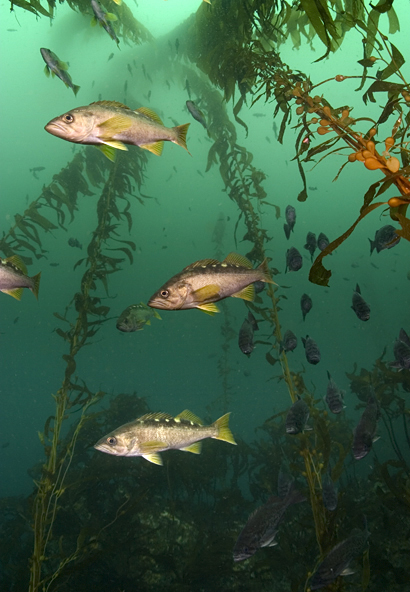
Olive rockfish, (Sebastes serranoides) and blue rockfish (Sebastes
mystinus) often school together. In this photograph, one can see the
boundary between warmer, murky, plankton-rich water above and clearer, colder
water below. Fishwatching enthusiasts should note that olive rockfish appear
nearly identical to yellowtail rockfish (Sebastes flavidus). A high
resolution version of this photograph was sent to rockfish expert, Dr. Milton
Love for identification.
"East Pinnacles", Carmel Bay, California
July 3, 2005
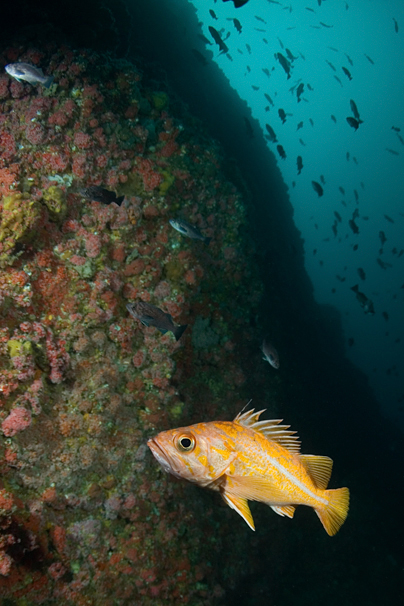
A canary rockfish (Sebastes pinniger) rises from the depths into a school
of its blue rockfish (Sebastes mystinus) cousins. The first time I dove
the pinnacle I was impressed by the density of encrusting life. It's likely the
result of the stiff currents here. On the dive on which this shot was taken, the
current went from light to outrageously strong and back in about an hour.
"Orca Pinnacle", Big Sur, California
August 27, 2006













